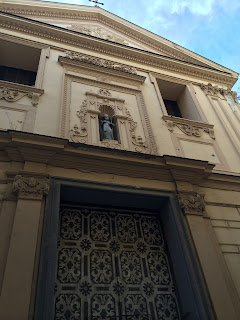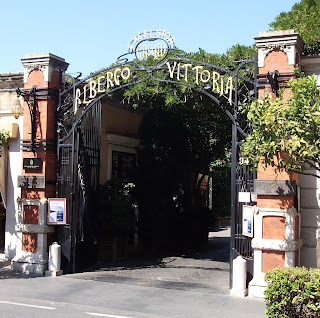Sorrento had defensive walls built to protect it as long ago as the Greek era, centuries before the birth of Christ.
 |
| Entrance to Porta Parsano Nuova |
When the resort became part of the Roman Republic the walls were added to and improved and the Romans built over the original Greek town following the same layout.
During the Roman period, Sorrento was completely surrounded by walls, with five entrance gates, to protect the town from the sea and from invaders from inland. A series of towers were built to defend the gates and these continued to protect Sorrento in the middle ages. When invaders were sighted sentinels would sound the alarm and local people would leave whatever they were doing in order to escape.
In the 16th century, after a catastrophic invasion of the town by Turkish pirates, the walls were rebuilt to provide a more robust line of defence for the local people.
 |
| The top of the old walls round Sorrento |
But it is now possible to see remains of the ancient Greek walls below street level at Porta Parsano Nuova, where they have been exposed and put on public display.
There is free admission to the site, which can be accessed from Via Antonino Sersale, a left turn off Via degli Aranci that leads to Corso Italia.
During the excavations, pottery, fragments of mosaics, glass, bones and iron objects were found, proving that the original Greek gate had once been filled in and bricked up. It was reopened and widened in the 18th century to form the present Porta Parsano Nuova.
This was the beginning of a redesign for the centre of Sorrento, which led to the widening of Corso Italia and the creation of Piazza Tasso.
It was made bigger than the previous main square, Piazza Castello, which had been named after a castle that no longer exists.
 |
| The gateway to the ancient site |
The opening of the Bastion of Parsano to the public has been seen as an important step by the local authority towards promoting Sorrento’s many other historical sites and monuments.
The site is open from 10 am to 1 pm and during the height of the summer is also open in the evenings from 7 pm to 10pm.
The site is open from 10 am to 1 pm and during the height of the summer is also open in the evenings from 7 pm to 10pm.
Miraculously, the Greek Gate in Via Marina Grande, which you pass through to get down to the seafront, is still in fine condition even though it was erected as long ago as the fourth century BC.











